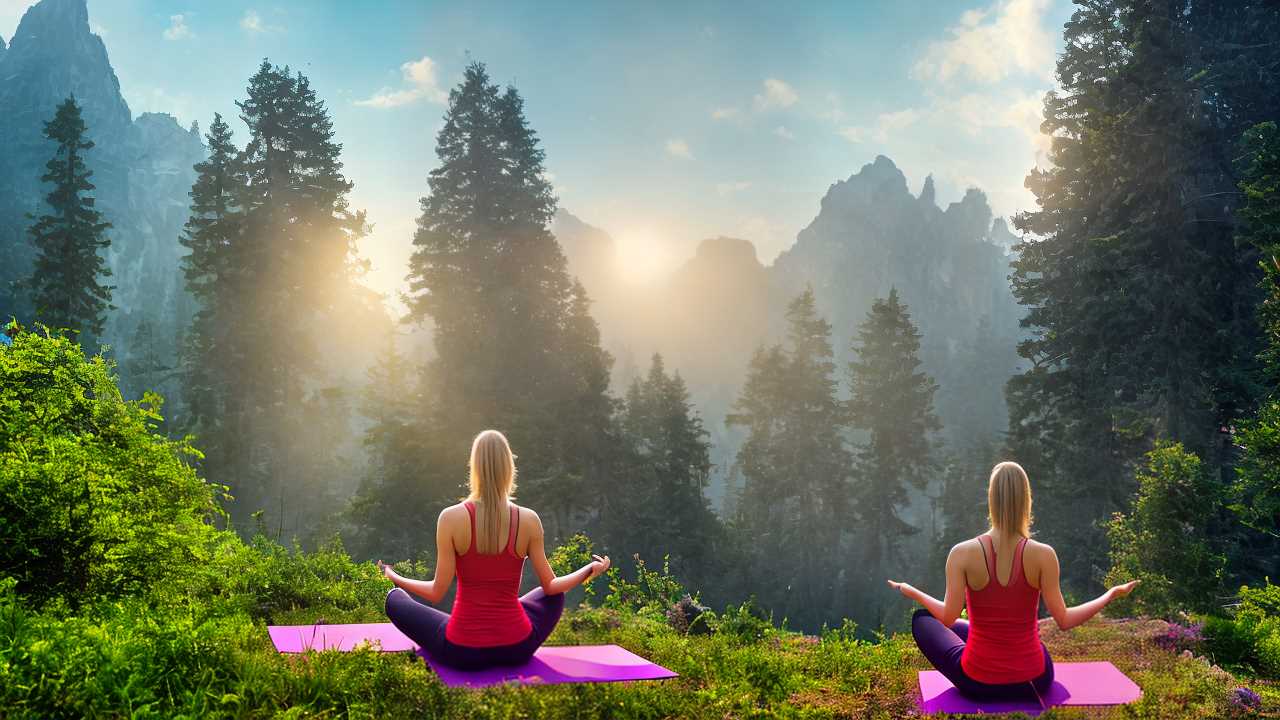Have you ever pondered why yoga poses hold such prowess in alleviating stress?
The answer lies in the intricate connection between body movements, breath awareness, and mental relaxation that yoga encapsulates. These ancient postures not only help in physical relaxation but also foster mental clarity and emotional balance.
As you explore the multifaceted benefits of yoga poses for stress relief, you will uncover a treasure trove of insights into enhancing your overall well-being.
Key Takeaways
- Yoga poses target specific muscle groups for relaxation and stress release.
- Breath-centered practices regulate breathing patterns and induce relaxation.
- Mindfulness in yoga enhances self-awareness and reduces stress.
- Balancing energy flow aids in stress reduction and emotional release.
Physical Benefits of Yoga Poses
Are you looking to discover the physical benefits that yoga poses can offer for relieving stress and tension in your body?
Engaging in the physical practice of yoga, particularly Hatha yoga, can provide a multitude of advantages when it comes to stress relief. Yoga poses target areas like the neck, shoulders, and back, promoting relaxation and easing tension. By exercising every muscle in your body, these poses effectively release physical and mental stress. Additionally, practicing yoga postures enhances flexibility and functional mobility, reducing stiffness and improving overall well-being.
Furthermore, engaging in yoga poses aids in reducing cortisol levels, which are linked to stress and anxiety. Regular practice not only reduces cortisol but also enhances blood circulation, oxygenation, and energy flow throughout your body. This improved circulation contributes to stress reduction and promotes a sense of relaxation.
Mental Benefits of Yoga Poses
Discover how engaging in yoga poses can significantly enhance your mental well-being by promoting relaxation, reducing stress, and fostering mental clarity.
Yoga poses require focus and concentration, which can help improve mental clarity as you actively engage with each posture. By calming both the mind and body, practicing yoga poses promotes relaxation, helping to release tension and reduce stress levels.
This release of tension can lead to an overall improvement in mental well-being. Moreover, the practice of yoga poses has been shown to alleviate symptoms of anxiety and depression, contributing to better mental health.
Regular engagement with yoga poses enhances awareness, concentration, and emotional balance, providing a holistic approach to mental wellness. Through the combination of physical movement, breath work, and mindfulness, yoga poses offer a comprehensive tool for managing stress, enhancing mental health, and promoting overall well-being.
Breath-Centered Practices in Yoga
Implementing breath-centered practices in yoga significantly enhances your ability to induce relaxation and calm the mind by focusing on regulating and deepening your breath. These practices are essential for stress relief and overall mental well-being. Here are four key points to consider:
- Regulating Breath: Breath-centered practices, like Pranayama, help regulate your breathing patterns, promoting relaxation and reducing stress levels.
- Activating Parasympathetic Nervous System: Deep breathing techniques in yoga activate the parasympathetic nervous system, signaling your body to relax and unwind.
- Improving Mental Well-being: Research indicates that breath work in yoga can lower cortisol levels, alleviate anxiety, and enhance your mental state, contributing to overall well-being.
- Enhancing Mind-Body Connection: By emphasizing breath awareness and control, yoga poses strengthen the mind-body connection, aiding in stress relief and promoting mental clarity.
Breath-centered practices in yoga not only enhance relaxation but also improve your ability to manage stress effectively. By incorporating these techniques into your yoga routine, you can experience a profound sense of calmness and well-being.
Muscle Relaxation in Yoga Poses
When practicing yoga poses, you’ll experience targeted muscle relaxation in areas like your neck, shoulders, and back, easing physical tension.
By stretching and holding these poses, tight muscles loosen, reducing stress and promoting relaxation throughout your body.
Specific postures can help release muscle knots and tightness, allowing for improved blood circulation and decreased muscle tension.
Relaxing Effects on Muscles
Stretching and lengthening in yoga poses play a crucial role in promoting muscle relaxation, aiding in the release of tension and reducing physical stress in the body. Here are some key points to consider:
- Yoga poses promote muscle relaxation through stretching and lengthening tight muscles.
- Stretching in yoga poses helps release tension and reduce physical stress in the body.
- Muscle relaxation in yoga poses can alleviate muscle knots and improve flexibility.
- The controlled movements in yoga poses target specific muscle groups for relaxation.
Physical Tension Release
In yoga practice, your muscles undergo a process of stretching and contracting, facilitating the release of physical tension and promoting relaxation.
Muscle relaxation in yoga poses is key for reducing stiffness and soreness, easing physical stress that accumulates in your body. By targeting specific muscle groups like the neck, shoulders, and back, these poses help alleviate built-up tension.
Holding these poses allows your muscles to lengthen and relax, providing a deep release of stress and tightness. As you regularly practice yoga poses, you’ll notice an improvement in muscle flexibility, reducing physical strain and contributing to your overall well-being.
These relaxation techniques through yoga can be a powerful tool in managing your muscle tension and promoting a sense of calm.
Mindfulness and Stress Relief
Engage in mindful yoga poses to cultivate a state of present awareness and alleviate stress effectively.
- Focus on the Present: Mindfulness in yoga poses helps you stay in the moment, reducing stress linked to past or future events.
- Develop Self-Awareness: Practicing mindfulness during yoga aids in understanding and accepting yourself, crucial for stress relief.
- Deep Breathing: Mindful yoga encourages deep breathing, triggering the body’s relaxation response and reducing stress hormones like cortisol.
- Enhance Concentration: Mindfulness techniques in yoga improve concentration and attention, shifting focus away from stress triggers.
Yoga Poses for Relaxing the Body
When you’re looking to relax your body through yoga, focusing on releasing tension, practicing calming breathing techniques, and strengthening your mind-body connection can be key.
Body tension release poses like Child’s Pose and Corpse Pose are great for easing physical stress, while incorporating breathing exercises like Cat-Cow Pose can enhance mental clarity and relaxation.
Body Tension Release
To ease body tension and promote relaxation, incorporating specific yoga poses that target muscle groups is essential for reducing stress and increasing overall well-being. Here are four essential points to consider when looking to release body tension through yoga:
- Stretch and Relax: Poses like Child’s Pose and Forward Fold are ideal for stretching and relaxing tight muscles, reducing physical stress.
- Improve Circulation: Yoga postures help increase blood circulation, aiding in the release of muscle tension and promoting relaxation.
- Gentle Movements: Poses like Cat-Cow and Downward Dog encourage gentle movements to ease body stiffness and enhance overall well-being.
- Enhance Flexibility: Regular practice of yoga poses can improve flexibility, reduce muscle tightness, and enhance body awareness, contributing to stress relief.
Calming Breathing Techniques
Start your relaxation journey with calming breathing techniques in yoga to soothe your body and reduce stress. Deep breathing, like in poses such as Child’s Pose or Corpse Pose, can help quiet your mind and calm your nervous system.
By engaging in controlled breathwork, you activate your parasympathetic nervous system, bringing about a sense of calmness and relaxation. Yoga poses that focus on breathing, such as Bridge Pose or Seated Forward Fold, encourage mindful breathing, easing tension and anxiety.
Mindful breathing techniques in yoga enhance oxygen flow, lower cortisol levels, and induce a state of relaxation for stress relief. Embrace these practices to find peace and tranquility within yourself.
Mind-Body Connection Practice
Engage your mind and body in a harmonious union through the practice of yoga poses designed to relax your body and promote stress relief.
- Mind-Body Connection: Yoga poses enhance the connection between your mental and physical well-being.
- Muscle Relaxation: Specific poses target areas of tension, releasing physical stress from the body.
- Deep Breathing: The practice of yoga encourages deep breathing, reducing anxiety and promoting relaxation.
- Overall Well-being: Regularly engaging in yoga poses can lead to a calmer mind, reduced stress levels, and improved overall well-being.
Balancing Energy Through Yoga Poses
Enhance your well-being and inner peace by incorporating balancing yoga poses into your routine. Yoga poses play a crucial role in balancing the body’s energy flow, aiding in stress reduction and relaxation.
These poses specifically target blocked energy channels, releasing tension and fostering a profound sense of calmness. By engaging in a variety of balancing poses, you can effectively release both physical and mental blockages that contribute to stress and anxiety.
The stability achieved through balancing poses not only strengthens the body but also calms the mind, promoting a harmonious equilibrium. Regular practice of these poses facilitates the management of stress by ensuring a balanced energy flow throughout your body.
Embrace these balancing yoga poses to experience the transformative power they hold in stabilizing your energy and promoting overall well-being.
Emotional Release Through Yoga
Facilitating emotional release through yoga poses involves targeting specific areas in the body where stress and tension tend to accumulate. When practicing yoga poses for emotional release, consider the following:
- Release Stored Tension: Yoga poses can help release pent-up emotions and provide a sense of catharsis by targeting areas where stress is stored in the body.
- Stimulate Relaxation Response: Certain yoga poses activate the parasympathetic nervous system, triggering a relaxation response that supports emotional release.
- Promote Mental Clarity: The physical movements and stretches in yoga poses aid in releasing emotional blockages, leading to mental clarity and emotional relief.
- Embrace Mindful Movement: Through deep breathing and mindful movement in yoga poses, individuals can release emotional tension stored in the body, promoting overall well-being and emotional balance.
Frequently Asked Questions
How Does Yoga Help With Stress Relief?
When you do yoga, it helps with stress relief by connecting your mind and body, increasing breath awareness, triggering a relaxation response, regulating cortisol levels, managing emotions, reducing stress hormones, easing muscle tension, and enhancing mental clarity.
What Are the Positive Effects of Yoga on Stress?
When you practice yoga, your mind and body unite, breathing eases tension, muscles relax, blood flows freely, your mind calms, cortisol drops, focus sharpens, and emotions find release, bringing peace within.
How Much Does Yoga Reduce Stress?
Yoga practice can significantly reduce stress levels by lowering cortisol. Just 10 minutes a day can improve stress management and emotional well-being. Mind-body techniques foster a relaxation response, enhancing your overall stress reduction and emotional well-being.
How Does Yoga Affect Anxiety and Stress?
When you practice yoga, your mind and body connect like puzzle pieces, calming your nerves. Deep breaths relax muscles, balance hormones, and boost focus. Meditation brings emotional release, reducing stress hormones and anxiety levels.
Conclusion
As you continue to practice yoga poses for stress relief, remember that each posture is like a gentle wave, soothing and calming your body and mind.
Embrace the benefits of relaxation, mindfulness, and breath control to find balance and inner peace.
Keep flowing with the practice, just like a river gracefully navigating its course, allowing stress to melt away with each breath and movement.
Yoga poses are your pathway to a centered and tranquil state of being.




